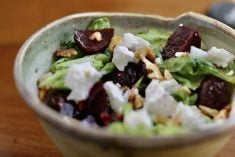This past month we have been redecorating our home. One of the biggest challenges was removing wallpaper, sticky-backed plastic hooks and stickers from walls that have been well used for many years.
One of the products recommended for this removal was GooGone. It works well, as does solvent or paint thinner, and plenty of elbow grease. Along with painting comes forced spring cleaning, sorting, discarding and recycling.
All in all, the effort is well worth it, and gives us a fresh new outlook for spring. Our dugout is overflowing, and this year’s crop germination looks promising.
Read Also

Communication key to bridging generation gap
Each generation is shaped by the predominant forces at play during their formative years. Acknowledging these influences can improve communication among the generations.
TEAM Resources recently received a publication prepared at the Beef Information Centre. This booklet, called Food Habits of Canadians, contains research highlights from a recent major study. This is the first comprehensive Canada-wide nutrition survey since one done in the early 1970s. This recent survey shows:
- The mean intake of fat has been reduced from 40 percent to 30 percent of energy since 30 years ago.
- Only red meat eaters were able to meet their daily recommended nutrient intakes for iron and zinc.
- Only milk drinkers met their daily recommended nutrient intakes for calcium.
- Those who met their daily recommended folic acid (folate) intake were those who consumed orange juice and more vegetables.
- Almost half of adult women and almost 60 percent of female teens did not have the minimum number of meat and alternative products.
- More than half of all females and adult males, and more than 40 percent of teen males are not consuming the minimum number of milk products.
- Almost half of the female teens and more than half of the adults and male teens did not consume the minimum five servings of vegetables and fruit per day.
- Thirty percent of adults and male teens, and more than 40 percent of female teens are not consuming the minimum number of servings from the grain food group.
- A recent University of British Columbia study comparing diets of vegetarian, past vegetarian and no-vegetarian women found that all three groups had similar energy intakes.
Among these health-conscious women, choosing a vegetarian diet was not associated with differences in weight status, weight perceptions or weight loss efforts.
- For all micronutrients, the mean intake has increased since 1970, indicating that diets have improved.
As a result of the survey, Canadians are being told to:
- Limit salt, alcohol and caffeine.
- Reduce saturated fat intake to below 10 percent of energy.
- Choose whole grain and enriched products more often.
- Choose dark green and orange vegetables and orange fruit more often.
- Choose lower fat milk products more often.
- Choose leaner meats, poultry and fish, as well as dried peas, beans and lentils more often.
Sunny Boy muffins
Dear TEAM: I was wondering if you could help me find the recipe for Sunny Boy Cereal muffins that used to be on the box of cereal in the 1970s and 1980s. I wrote the company that makes the present package to ask for the recipe, but did not get the old one that used to be on the box.
If I remember correctly, you soaked the cereal in sour milk, and raisins were optional. It made one dozen muffins. I’m looking forward to baking muffins again. – L.A., Melville, Sask.
Dear L.A.: I have not found the original Sunny Boy Cereal muffin recipe. If any readers happened to have cut out that recipe from the box years ago, please send it in.
This recipe is a healthy bran muffin recipe that I found on the Calgary Health Region website.
It appears to have many of the same ingredients that the cereal contains. I was out of raisins, so substituted dates. They turned out crispy on the outside, and moist and tasty. We enjoyed these in place of cereal for breakfast.
Bran muffins
Yield: 12 muffins
1 cup whole wheat 250 mL
flour
2 tablespoons oat bran 30 mL
3/4 cup packed brown 175 mL
sugar
1/2 teaspoon salt 2 mL
1 teaspoon baking 5 mL
powder
1 egg, slightly beaten
1/3 cup vegetable oil 75 mL
3/4 cup 2% milk 175 mL
1 teaspoon vanilla 5 mL
1/2 cup sunflower seeds 125 mL
1/2 cup raisins 125 mL
Combine the first five ingredients in a large bowl. In a small bowl, combine the egg, oil, milk and vanilla. Add the egg mixture, raisins and sunflower seeds to the flour mixture. With as few strokes as possible, mix until dry ingredients are just moistened. Drop into 12 muffin cups. Bake at 350 F (180 C) for 15-20 minutes.
Variation: Omit sunflower seeds and use one cup (250 mL) raisins.
Labelling of fresh produce
Dear TEAM: I am sending this information about labelling of fresh vegetables and fruits. According to Maria Gallagher, in the June 26, 2002, Philadelphia Inquirer, the following information indicates a way to know whether fresh fruits are organically grown, conventionally grown, or genetically modified.
Usually fruits have a little sticky label on them, which has a PLU number that helps to distinguish where they are grown. This also helps cashiers tell a Fuji apple from a Gala apple.
For conventionally grown fruit, the PLU code on the sticker consists of four numbers. Organically grown fruit has a five numeral PLU, prefaced by the number nine. Genetically modified fruit has a five-numeral PLU prefaced by the number eight.
So, a conventionally grown banana would be 4011, while an organic banana would be 94011, and a genetically engineered banana would be 84011. The numeric system was developed by the Produce Electronic Identification Board, an affiliate of the Produce Marketing Association. As of October 2001, the board had assigned more than 1,200 PLU numbers for individual produce items. – L.S., Bruno, Sask.
Dear L.S.: Thank you for suggesting this topic. I went to the Canadian Produce Marketing Association website to learn more about this labelling, and found the following information.
The association members are Canadian and international companies active in the marketing of fresh fruits and vegetables in Canada from the farmgate to the dinner plate. They are responsible for more than 90 percent of the fresh produce sold in Canada at an estimated value of $6 billion.
The number of produce items sold today has increased from approximately 100 to 500 in less than 20 years. The need for improvements in the accuracy of electronic product identification at checkout has led to the development of standard universal product codes and price look up codes for produce.
These codes improve efficiencies at checkout and throughout the food distribution system. These codes also provide the building block for other initiatives, such as case coding and electronic data interchange systems the industry will be implementing in the foreseeable future. Most consumers are aware of UPCs; fewer are aware of PLUs.
UPCs are used for produce sold in a fixed weight, such as a three-pound bag of carrots, or fixed count form, such as one bunch of carrots. The code is made up of 12 numbers and a corresponding bar code.
This symbol is printed directly on the packaging containing the produce or it is printed on the label, wrapper or twist tie, which is easily attached to the produce. This UPC symbol provides the means of electronic scanning of the product at checkout.
PLU codes are used to identify produce sold in bulk. It is a four-digit number preceded by a number sign (#4011 = bananas). Bulk produce is labelled individually with a PLU number.
The cashier enters the number, and the computer does the calculation. The five number prefix to this is the generic produce manufacturer number, and must always be used, because wholesalers or retailers who purchase large volumes of a given product will have many suppliers of the same item.
Traceability is important. The use of a generic manufacturer number coupled with a standardized item number simplifies database management.
For more information, contact: Canadian Produce Marketing Association, 9 Corvus Court, Ottawa, Ont., K2E 7Z4, 613-226-4187, fax: 613-226-2984, question@cpma.ca, or www.cpma.ca.
To order a copy of A Guide to Coding Fresh Produce, contact: Eboni Wall, Produce Marketing Association, 1500 Casho Mill Road, Box 6030, Newark, Delaware, 9714-6036, U.S.A., 302-738-7100, or fax 302-731-2409.
The guide comes in a three-ring binder and includes a 31/2 inch computer diskette. It has been designed as a management tool for all the industry, and contains the most recent listing of product codes, information on how they should be used, as well as printing instructions.
Barbara Sanderson is a home economist from Rosetown, Sask., and one of four columnists comprising Team Resources. Send correspondence in care of this newspaper, Box 2500, Saskatoon, Sask., S7K 2C4 or contact them at team@producer.com.














